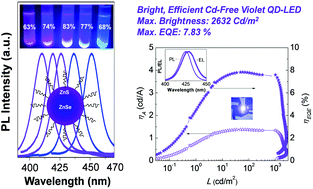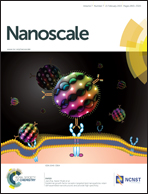Bright, efficient, and color-stable violet ZnSe-based quantum dot light-emitting diodes†
Abstract
In this paper, highly stable violet-blue emitting ZnSe/ZnS core/shell QDs have been synthesized by a novel “low temperature injection and high temperature growth” method. The resulting nearly monodisperse ZnSe/ZnS core/shell QDs exhibit excellent characteristics such as a high color saturation (typical spectral full width at half-maximum between 12 and 20 nm), good emission tunability in the violet-blue range of wavelengths from 400 to 455 nm, a high absolute PL quantum yield (up to 83%), and superior chemical and photochemical stability. By employing ZnSe/ZnS core/shell quantum dots (QDs) as emitters with a fully solution processable method, bright, efficient, and color-stable violet Cd-free quantum dot-based light-emitting diodes (QD-LEDs) with maximum luminance up to 2632 cd m−2 and a peak EQE of 7.83% have been demonstrated successfully. Considering the factors of the photopic luminosity function, the brightness and efficiency results of such violet QD-LEDs not only represent a 12-fold increase in device efficiency and an extraordinary 100 times increase in luminance compared with previous Cd-free QD-LEDs but also can be much superior to the best performance (1.7%) of their Cd-based violet counterparts. These results demonstrate significant progress in short-wavelength QD-LEDs and shed light on the acceleration of commercial application of environmentally-friendly violet QD-based displays and lighting.


 Please wait while we load your content...
Please wait while we load your content...